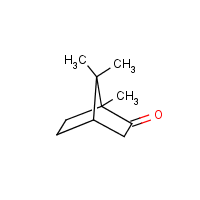D-Camphor
Agent Name
D-Camphor
CAS Number
464-49-3
Formula
C10-H16-O
Major Category
Biological Agents

Synonyms
(+)-2-Bornanone; (1R)-(+)-Camphor; (1R)-Camphor; (1R,4R)-1,7,7-Trimethylbicyclo(2.2.1)heptan-2-one; (R)-(+)-Camphor; (R)-Camphor; Alcanfor; Bicyclo(2.2.1)heptan-2-one, 1,7,7-trimethyl-, (1R)-; Camphor USP; Camphor, (+)-; Camphor, (1R,4R)-(+)-; D-(+)-Camphor; Formosa camphor; Japanese camphor; Laurel camphor; d-2-Bornanone; d-2-Camphanone; d-Camphor; (+)-Bornan-2-one; Bicyclo(2.2.1)heptan-2-one, 1,7,7-trimethyl-, (1R,4R)-; Bicyclo(2.2.1)heptan-2-one, 1,7,7-trimethyl-, (1theta)-; (+)-Camphor; Camphor, D-; [ChemIDplus] UN2717
Category
Plant Oils and Extracts
Description
Colorless, transparent solid; [Merck Index] Colorless or white solid with a penetrating odor; [CAMEO] White crystalline solid; [Alfa Aesar MSDS]
Sources/Uses
Naturally occurring form of camphor; Used in organic synthesis and as an odorant, flavoring agent, moth repellent, preservative, and plasticizer in cosmetics; Also used as a topical analgesic and antipruritic; [Merck Index] Used primarily in medicaments; Used industrially as a plasticizer for cellulose esters and ethers, to make plastics, and as a solvent in cosmetics; [NTP - Final Report on Developmental Toxicity] Used as a coloring agent, flavor enhancer, and flavoring agent or adjuvant; [FDA] A major constituent of pine oil; Used as a plasticizer for cellulose nitrate, explosives, and lacquers, to make incense, in varnishes, odorants, embalming fluids, pyrotechnics, insecticides, insect repellents, and for moth and mildew proofing; [NTP]
Comments
Considered highly toxic by ingestion, with an estimated human lethal dose of 3.5-35 grams (50-500 mg/kg); Autopsies of human poisonings have shown damage to the liver, kidney, and brain; [NTP - Final Report on Developmental Toxicity] Camphor used topically during pregnancy in not likely to cause teratogenic effects; [TERIS] Safe when used as a flavoring agent in food; [JECFA] A severe skin, eye, mucous membrane, and upper respiratory tract irritation; High concentrations may cause corrosive injuries; May cause CNS depression and other nervous system effects; Harmful by ingestion, inhalation, and skin absorption; [NTP] Included in list of "established contact allergens in humans"; [EC: Scientific Committee on Consumer Safety: Fragrance allergens in cosmetic products (2011)] A skin and strong eye irritant; [Alfa Aesar MSDS] See "Camphor, synthetic."
Biomedical References
Exposure Assessment
Explanatory Notes
VP = 1 mm Hg at 41.5 deg C; [NTP] The Guide in the Emergency Response Guidebook is for "Camphor."
NFPA
high ambient temp required
Adverse Effects
Skin Sensitizer
Yes
Neurotoxin
Other CNS neurotoxin
Hepatotoxin
Hepatoxic (a) from occupational exposure (secondary effect) or (b) in animal studies or in humans after ingestion
Diseases, Processes, and Activities Linked to This Agent
Diseases
Occupational diseases associated with exposure to this agent:
Processes
Industrial Processes with risk of exposure: